Lightning Fast Sichuan Noodles with Chilies and Scallions
This post may contain affiliate links. Please read my disclosure policy.

A few weeks ago, upon exiting Christopher Kimball’s Milk Street website, a pop-up email capture caught my attention: If I subscribed, I would get “12 recipes That [Would] Change The Way I Cook.”
What was there to lose? I subscribed, downloaded my PDF, began reading, and soon came across an article titled “Quick and Easy Sichuan Noodles” with a stunning photo captioned: “Scallions, sesame oil and seeds, plus pantry staples, flavor this simple, addictively good noodle dish.”
Incredibly, I had everything on hand to make the dish, which came together as quickly as promised. The first time I made it, I used fresh Chinese noodles that I had on hand, which worked well but I’ve since made the recipe with dried Japanese udon noodles, Milk Street’s recommendation, which worked even better.
The recipe, I learned, was inspired by Fuchsia Dunlop’s “emergency midnight noodles” from her cookbook Every Grain of Rice. Fuchsia makes the noodles with chili oil, which Milk Street has you make from scratch by heating grapeseed oil with red pepper flakes (and sesame seeds). It takes just a few minutes.
To bulk it up a bit, I’ve added thinly shredded cabbage and carrots, which I drain the hot noodles over to help soften them. I like the inclusion of vegetables, and though some sort protein would be a nice addition, too, I haven’t been missing it. Milk Street tops each serving with a fried egg, which they fry in the same skillet used to make the infused oil. Yum.
Here’s the play-by-play: Gather your ingredients. Milk Street recommends dried Japanese udon noodles for this dish.
For the sauce, you’ll need: soy sauce, rice vinegar, sesame oil, pepper flakes, sesame seeds, brown sugar and grapeseed oil or other neutral oil.
If you’re adding vegetables, prep them before you boil the noodles. I use my food processor to shred the carrots and my knife to slice the cabbage. The scallions need to be sliced and the whites and greens separated.
Boil the noodles in salted water (left), while you infuse the grapeseed oil with chilies and sesame seeds (right).
Adding the scallion whites to the sauce, heat now turned off.
Finish the sauce by stirring in the mix of soy sauce, brown sugar, sesame oil, and rice vinegar.
When the noodles have boiled…
… drain them over the vegetables in a colander.
Careful of the curious kitty!
Transfer vegetables and noodles to bowl and add the scallion greens.
Add the sauce.
Toss.
Eat.
These are also really delicious with the fresh udon noodles. I used the Nasoya brand here. Really yummy. No carrots in this version.

Sichuan Noodles with Chilies and Scallions
- Total Time: 20 minutes
- Yield: 4
Description
Adapted from Milk Street (If you subscribe to their newsletter, you’ll get this recipe along with this curried lentil recipe and 10 other enticing ones for free.)
I’ve made a few changes:
- I add vegetables: cabbage and carrots. If you wish to add vegetables, too, be sure to choose vegetables that will soften under the heat of boiling water poured over them. Finely chopping or shredding the vegetables will help. I think Romaine lettuce would work nicely here, too.
- I use 2 tablespoons of sugar, and I find it to be sweet enough, but use the full 3 if you wish.
- I have yet to top each serving with a fried egg, but if you wish to do so, fry it directly in the skillet you use to infuse the oil with the chilies, sesame seeds, and scallions.
Next time, I may try infusing the grapeseed oil with crushed Sichuan peppercorns. I love the numbing mala sensation. I’ll keep you posted.
Ingredients
- kosher salt
- 5 tablespoons soy sauce
- 3 tablespoons unseasoned rice vinegar
- 2 to 3 tablespoons packed dark brown sugar (I use 2; original recipe calls for 3)
- 1 tablespoon toasted sesame oil
- ¼ cup grapeseed or other neutral oil
- 5 teaspoons sesame seeds
- 1 to 1¼ teaspoons red pepper flakes
- 12 scallions, white and green parts thinly sliced on the bias, reserved separately
- 1 small cabbage, finely sliced, optional
- 1 to 2 large carrots, grated using the shredder attachment of a food processor, optional
- 12 ounces dried udon noodles, lo mein or spaghetti or fresh udon noodles (fresh udon, such as the Nasoya brand, are my favorite)
Instructions
- Bring a large pot of salted water (I use 1 tablespoon kosher salt) to a boil. In a small bowl, whisk together the soy sauce, vinegar, sugar and sesame oil.
- In a 12-inch skillet over medium, heat the grapeseed oil, sesame seeds and pepper flakes (use 1 teaspoon or less if you are sensitive to heat) until the pepper flakes are fragrant and the seeds begin to brown, 3 to 5 minutes. Off heat, stir in the scallion whites, then add the soy sauce mixture. Set aside.
- If you haven’t prepped the vegetables, do so now: Finely slice the cabbage. Shred the carrots in a food processor using the shedder attachment. Place them in a large colander in the sink.
- Cook the noodles until al dente—my dried Udon noodles take 7 minutes, but be sure to check the package of the noodles you are using—then drain the noodles directly over the vegetables in the colander.
- Transfer the noodles and vegetables to a large serving bowl. Add the scallion greens. Bring the sauce in the skillet on the stovetop just up to a simmer (if it has cooled down), then pour over the noodles and vegetables. Toss to combine. Serve.
- Prep Time: 15 minutes
- Cook Time: 5 minutes
- Category: Dinner
- Method: Boil, Sauté
- Cuisine: Chinese
This post may contain affiliate links. Please read my disclosure policy.


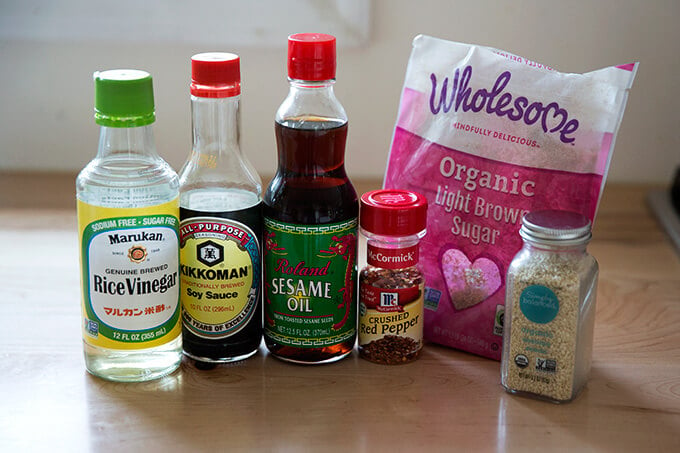
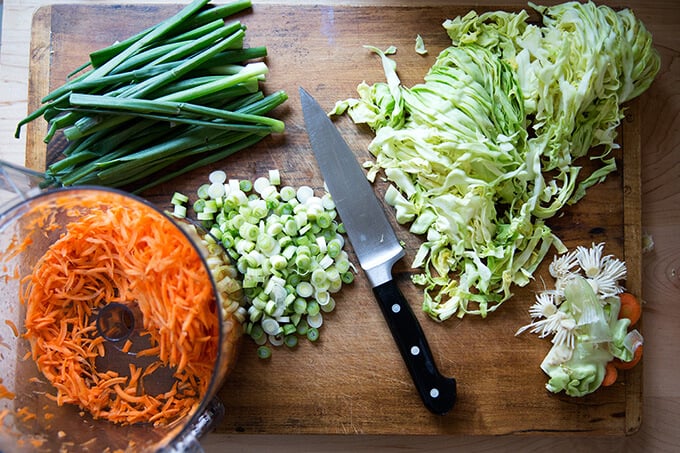
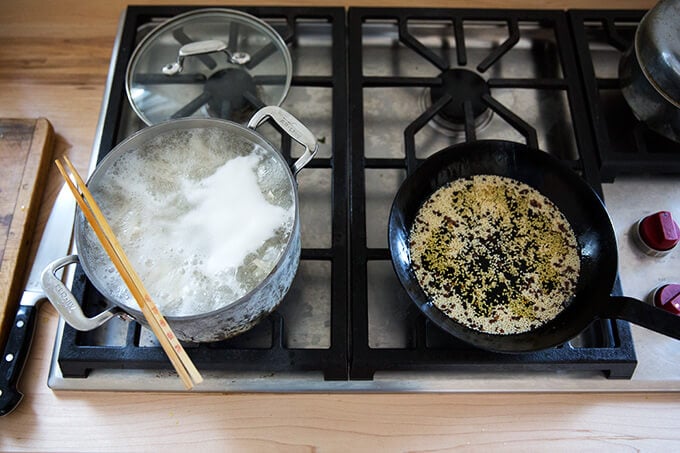



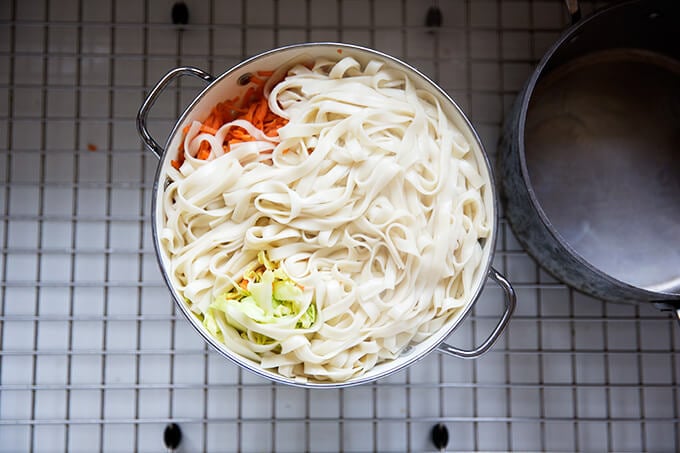
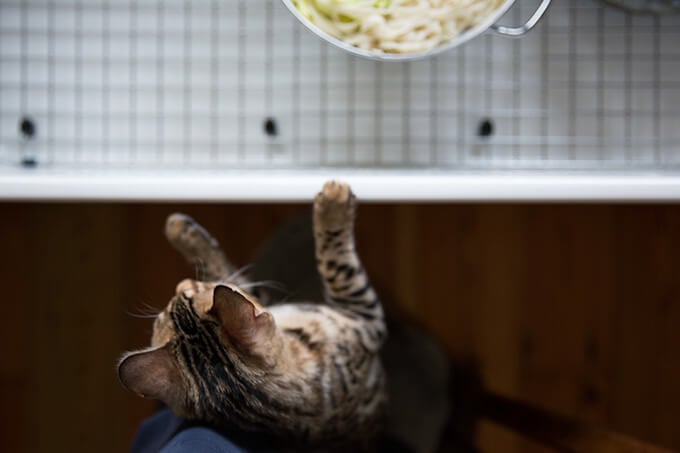
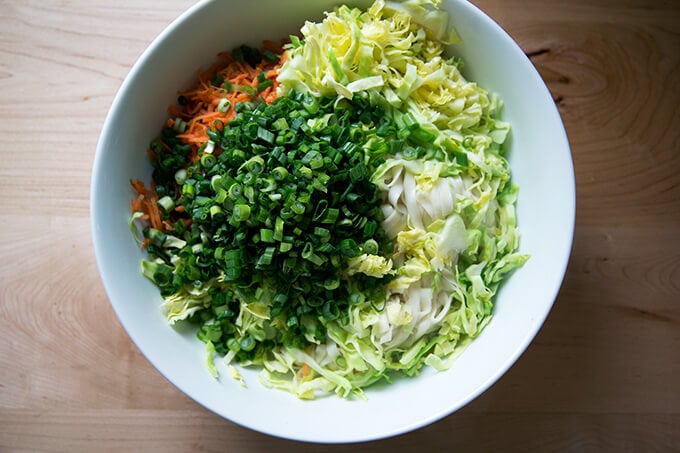

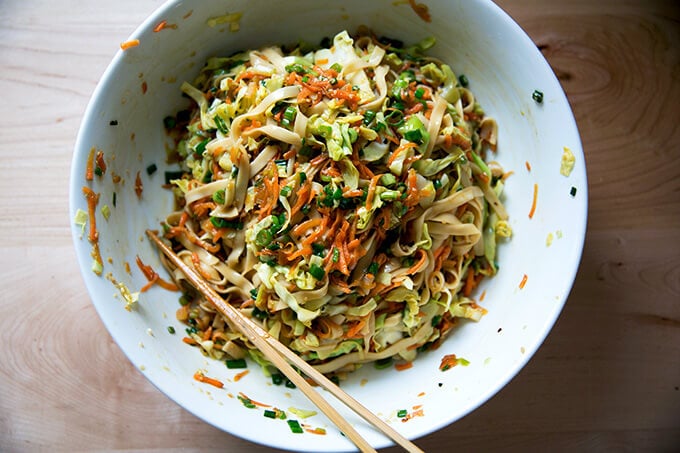












77 Comments on “Lightning Fast Sichuan Noodles with Chilies and Scallions”
Made this tonight because I had the rest of a gigantic head of cabbage to use and it was easy and delicious. I had to use up some chicken and zucchini as well, which I sautéed in sesame oil in a separate pan and mixed in with the rest at the end. Thanks for the great recipe.
Oh yum! Beth, that all sounds amazing 💕💕💕
Just made this with shredded zucchini and carrot, and the black sesame seeds / soba noodles I had on hand🙏🏻🙏🏻🙏🏻 Thank you, as always for this delicious recipe!
So nice to hear this, Brittany! Shredded zucchini and carrot is brilliant this time of year … I’m overloaded with both from my CSA. Thanks for writing!
I love the idea of this sort of recipe, have never eaten or cooked it. But am always put off by the fish sauce. (I hate fish!)
This recipe sounded great, I prepared exactly as directed-except veggies.
The sauce! It was scrumptious!
My husband, who NEVER enjoys leftovers, ate this for lunch, dinner and again for lunch. He just kept begging me to make sure I add this to his favorite recipes. He also repeated “This is so good!”
Now, I loved this dish. Not only was it delectable to eat, but it was fast and easy. The only bad thing was waiting for the noodles to boil.
The only changes were:
Using brussel sprouts-shaved & carrots-shredded large.
Drained noodles over veggies, and they were ever so too crunchy. I put it back in the noodle pot, and popped the lid on. Perfect!
Added some spicy sausage that was cooked already.
Today I am making it with more veggies. Using bok choy, brussel sprouts, carrots & broccoli. Will be adding some roasted chicken also.
This is faster than ordering out, tastier and a great way to use up veggies.
The sauce is the star of this dish!
So great to hear all of this, Melody!! All of your substitutions and changes sound delicious. I love how this one can be changed up in countless ways. Thanks for writing!
Adding yet another to the list of ‘recipes from Ali that we love’. This was fantastic, and a flexible recipe that allows for incorporating things from the fridge that need to be eaten. We added some tofu and shiitake mushrooms which I sautéed in advance, then added edamame to the mix in the colander. Will make again for sure. Thank you!
Wonderful to hear this, Krista! Tofu + shiitake mushrooms sound amazing here. Love edamame, too. Thanks for writing!
Hi Ali,
Thanks for another five star recipe. I have found so many wonderful recipes on your website that I feel like a miner that just found a motherlode of gold.
My only add was some thinly sliced asparagus. The flavors and texture were spectacular and the recipe came together so easy.
I will be sharing the recipe link with my daughters, family and friends.
So nice to hear this, Bruce 🙂 Love the idea of adding asparagus here for flavor and texture. Thank you for the kind words and thanks for writing! Hope all is well.
This is a Game changer for my Asian cooking! I followed your recipe with only one change – I tossed the colander full of drained noodles and veggies into the skillet and gave it all a toss vs. pouring the sauce over the noodles/veggies. OMG DELICIOUS! But what I’m so crazy about with this is the technique that was not on my radar. The method ensures that veggies don’t cook beyond tender/firm that I often lose in the last few minutes of stir fry/pan fry noodles.
I will take this technique all over the place with different veggies and noodes. Thank you, Ali!
So great to hear this! I love this technique, too, because I love crisp-tender veg as well. Thanks so much for writing!
This is so easy and so good. I’ve made it with cabbage before but just made a summer version the other night. Boiled green beans with the noodles for about 5 mins, sauteed red bell peppers with the sesame seeds. Added roasted chicken. Dinner done in 20 mins! Kids liked it too (left out the pepper flakes).
So great to hear this, Shelley! Love that you added chicken for protein and that the kiddos approved! I have green beans from the farm share … will try that next!
Omg I can’t wait to make this
Chilies? I was confused by the title of this “Lightning Fast Sichuan Noodles with Chilies and Scallions” as I didn’t see Chilies in the ingredient list, but after reading through this a bit, I think the Chilies refers to the Red Pepper Flakes. Assuming that is correct, I will give this a try as it sounds quick and delicious.
Living in the American Southwest, “Chilies” means something entirely different here.
Thanks!
Hi Ken! Yes, it refers to the chili flakes, but if you have fresh chilies available, feel free to swap those in. Hope you like it!
Drain the noodles over the vegetables in the colander?? Genius!
🙂 🙂 🙂